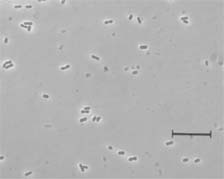Psychrobacter is a member of the gamma Proteobacteria family. This genus is commonly isolated from cold environments, including soil, sea-ice [1], and the skin and gills of fish [2]. It has also been associated with food spoilage and is often resistant to irradiation used for food preservation [3]. Psychrobacters have also been identified from a variety of human sources [4]. The strain Psychrobacter sp. PRwf-1 was isolated from the skin and gills of Lutjanus vivanus caught off the coast of Loíza in northeastern Puerto Rico. Psychrobacter sp. PRwf-1 will be deposited into the DSMZ (the German Resource Center for Biological Materials). Strain PRwf-1 is a small, non-motile coccoid rod often found in pairs. On TSA and marine agar, it produces smooth, non-pigmented colonies. This strain was selected for sequencing based on its physiological differences with the Psychrobacter strains isolated from cold environments, including a temperature range shifted to warmer temperatures. Through analysis of the transcriptome, experiments can be designed to assess microbial survival under a variety of harsh conditions and compare the endurance of strains isolated in constantly cold environments ( Psychrobacter sp. 273-4 and Psychrobacter cryohalolentis K5) with those of PRwf-1, a warm environment equivalent. Understanding the adaptive traits that allow specific strains of related organisms long-term survival under environmental stress is of interest to the field of Astrobiology. Organisms that survive hostile environments may be used as models for understanding cellular responses under environmental conditions prevailing in the universe. References: 1. Bowman, J.P., et al., Diversity and association of Psychrophilic bacteria in Antarctic sea ice . Applied and Environmental Microbiology, 1997. 63(8): p. 3068-3078. 2. Scholes, R.B. and J.M. Shewan, The present status of some aspects of marine microbiology . Advances in Marine Biology, 1964. 2: p. 133-169. 3. Firstenberg-Eden, R., D.B. Rowley, and G.E. Shattuck, Factors affecting inactivation of Moraxella- Acientobacter cells in an irradiation process. Applied and Environmental Microbiology, 1980. 40: p. 480-485. 4. Moss, C.W., et al., Cultural and chemical characterization of CDC groups EO-2, M-5 and M-6, Moraxella(Moraxella) species, Oligella urethralis, Acientobacter sp. and Psychrobacter immobilis. Journal of Clinical Microbiology, 1988. 26: p. 484-492. 5. Vishnivetskaya, T., et al., Low temperature recovery strategies for the isolation of bacteria from ancient permafrost sediments. Extremophiles, 2000. 4. 165-173.
|
||
|
||
Psychrobacter sp. PRwf-1

